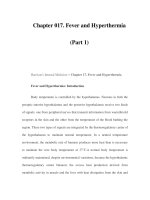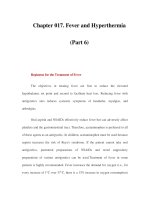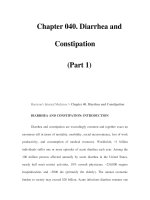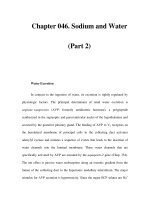Chapter 046. Sodium and Water (Part 6) docx
Bạn đang xem bản rút gọn của tài liệu. Xem và tải ngay bản đầy đủ của tài liệu tại đây (13.93 KB, 5 trang )
Chapter 046. Sodium and Water
(Part 6)
Hyponatremia in the setting of ECF volume expansion is usually associated
with edematous states, such as congestive heart failure, hepatic cirrhosis, and the
nephrotic syndrome. These disorders all have in common a decreased effective
circulating arterial volume, leading to increased thirst and increased AVP levels.
Additional factors impairing the excretion of solute-free water include a reduced
GFR, decreased delivery of ultrafiltrate to the diluting site (due to increased
proximal fractional reabsorption of Na
+
and water), and diuretic therapy. The
degree of hyponatremia often correlates with the severity of the underlying
condition and is an important prognostic factor. Oliguric acute and chronic renal
failure may be associated with hyponatremia if water intake exceeds the ability to
excrete equivalent volumes.
Hyponatremia in the absence of ECF volume contraction, decreased
effective circulating arterial volume, or renal insufficiency is usually due to
increased AVP secretion resulting in impaired water excretion. Ingestion or
administration of water is also required since high levels of AVP alone are usually
insufficient to produce hyponatremia. This disorder, commonly termed the
syndrome of inappropriate antidiuretic hormone secretion (SIADH), is the most
common cause of normovolemic hyponatremia and is due to the nonphysiologic
release of AVP from the posterior pituitary or an ectopic source (Chap. 334).
Renal free-water excretion is impaired while the regulation of Na
+
balance is
unaffected. The most common causes of SIADH include neuropsychiatric and
pulmonary diseases, malignant tumors, major surgery (postoperative pain), and
pharmacologic agents. Severe pain and nausea are physiologic stimuli of AVP
secretion; these stimuli are inappropriate in the absence of hypovolemia or
hyperosmolality. The pattern of AVP secretion can be used to classify SIADH into
four subtypes: (1) erratic autonomous AVP secretion (ectopic production); (2)
normal regulation of AVP release around a lower osmolality set point or reset
osmostat (cachexia, malnutrition); (3) normal AVP response to hypertonicity with
failure to suppress completely at low osmolality (incomplete pituitary stalk
section); and (4) normal AVP secretion with increased sensitivity to its actions or
secretion of some other antidiuretic factor (rare). Patients with the nephrogenic
syndrome of inappropriate antidiuresis have clinical and laboratory features
consistent with SIADH but undetectable levels of AVP. It is hypothesized that this
disorder is due to gain of function mutations in the V2 receptor.
Hormonal excess or deficiency may cause hyponatremia. Adrenal
insufficiency (Chap. 336) and hypothyroidism (Chap. 335) may present with
hyponatremia and should not be confused with SIADH. Although decreased
mineralocorticoids may contribute to the hyponatremia of adrenal insufficiency, it
is the cortisol deficiency that leads to hypersecretion of AVP both indirectly
(secondary to volume depletion) and directly (cosecreted with corticotropin-
releasing factor). The mechanisms by which hypothyroidism leads to
hyponatremia include decreased cardiac output and GFR and increased AVP
secretion in response to hemodynamic stimuli.
Finally, hyponatremia may occur in the absence of AVP or renal failure if
the kidney is unable to excrete the dietary water load. In psychogenic or primary
polydipsia, compulsive water consumption may overwhelm the normally large
renal excretory capacity of 12 L/d (Chap. 334). These patients often have
psychiatric illnesses and may be taking medications, such as phenothiazines, that
enhance the sensation of thirst by causing a dry mouth. The maximal urine output
is a function of the minimum urine osmolality achievable and the mandatory
solute excretion. Metabolism of a normal diet generates about 600 mosmol/d, and
the minimum urine osmolality in humans is 50 mosmol/kg. Therefore, the
maximum daily urine output will be about 12 L (600 ÷ 50 = 12). A solute
excretion rate of greater than ~750 mosmol/d is, by definition, an osmotic diuresis.
A low-protein diet may yield as few as 250 mosmol/d, which translates into a
maximal urine output of 5 L/d at a minimum urine tonicity of 50 mosmol/kg. Beer
drinkers typically have a poor dietary intake of protein and electrolytes and
consume large volumes (of beer), which may exceed the renal excretory capacity
and result in hyponatremia. This phenomenon is referred to as beer potomania.
Clinical Features
The clinical manifestations of hyponatremia are related to osmotic water
shift leading to increased ICF volume, specifically brain cell swelling or cerebral
edema. Therefore the symptoms are primarily neurologic, and their severity is
dependent on the rapidity of onset and absolute decrease in plasma Na
+
concentration. Patients may be asymptomatic or complain of nausea and malaise.
As the plasma Na
+
concentration falls, the symptoms progress to include
headache, lethargy, confusion, and obtundation. Stupor, seizures, and coma do not
usually occur unless the plasma Na
+
concentration falls acutely below 120 mmol/L
or decreases rapidly. As described above, adaptive mechanisms designed to
protect cell volume occur in chronic hyponatremia. Loss of Na
+
and K
+
, followed
by organic osmolytes, from brain cells decreases brain swelling due to secondary
transcellular water shifts (from ICF to ECF). The net effect is to minimize cerebral
edema and its symptoms.









